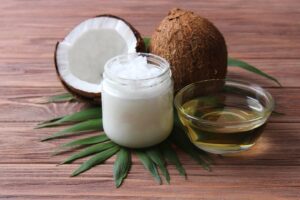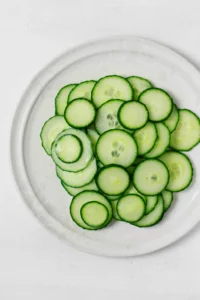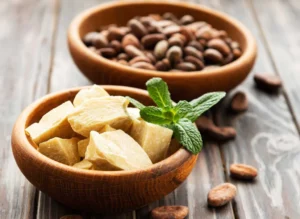Diabetes is a chronic condition that affects millions of people worldwide. One common yet often overlooked symptom of diabetes is dry skin. Diabetic dry skin can be uncomfortable and lead to complications if not properly managed. While conventional treatments exist, exploring natural remedies can provide additional support without the side effects of certain medications. In this blog post, we will delve into various natural remedies to help alleviate and prevent diabetic dry skin.
Contents
- 1 Does Diabetes Makes Skin Dry?
- 2 25 Best Natural Remedies for Diabetic Dry Skin
- 2.1 Hydration
- 2.2 Balanced Diet
- 2.3 Coconut Oil
- 2.4 Aloe Vera Gel
- 2.5 Oatmeal Baths
- 2.6 Essential Oils
- 2.7 Maintain Blood Sugar Levels
- 2.8 Avoid Harsh Soaps
- 2.9 Humidify Your Environment
- 2.10 Regular Exercise
- 2.11 Shea Butter
- 2.12 Honey
- 2.13 Cucumber Slices
- 2.14 Avocado Mask
- 2.15 Flaxseed Oil
- 2.16 Calendula Cream
- 2.17 Probiotics
- 2.18 Gentle Exfoliation
- 2.19 Witch Hazel
- 2.20 Mind-Body Practices
- 2.21 Glycerin
- 2.22 Cocoa Butter
- 2.23 Evening Primrose Oil
- 2.24 Turmeric Paste
- 2.25 Mango Seed Butter
- 3 Conclusion
Does Diabetes Makes Skin Dry?

Yes, diabetes can contribute to dry skin. There are several reasons why individuals with diabetes may experience dry skin:
- Poor Blood Circulation: Diabetes can lead to poor circulation, reducing the amount of oxygen and nutrients that reach the skin. This compromised blood flow can result in dryness, flakiness, and a lack of elasticity in the skin.
- Neuropathy: Diabetic neuropathy, a condition where nerves are damaged due to high blood sugar levels over time, can affect the nerves that control oil and moisture in the skin. As a result, individuals with diabetes may produce less oil, leading to dry and cracked skin.
- Dehydration: Elevated blood sugar levels can contribute to increased urination, leading to dehydration. When the body is dehydrated, the skin loses moisture, resulting in dryness.
- Infections: Individuals with diabetes are more prone to skin infections, and these infections can contribute to dry, itchy skin. Constant scratching can further damage the skin barrier, making it more susceptible to dryness.
- Medications: Some medications used to manage diabetes may have side effects that impact the skin. For instance, certain medications might contribute to dryness or skin irritation.
- Compromised Immune System: Diabetes can weaken the immune system, making individuals more susceptible to skin infections. Infections, in turn, can lead to dry and irritated skin.
25 Best Natural Remedies for Diabetic Dry Skin
Managing diabetic dry skin requires a holistic approach that includes lifestyle changes, dietary adjustments, and the use of natural remedies. Here are 25 natural remedies that can be effective in alleviating diabetic dry skin:
Hydration
Diabetic dry skin often results from dehydration, and maintaining optimal hydration is crucial. Drinking an adequate amount of water throughout the day helps replenish lost fluids and supports overall skin health. Water helps transport nutrients to skin cells and flush out toxins, promoting a healthy and hydrated complexion. Herbal teas, particularly chamomile and green tea, can be beneficial due to their antioxidant and anti-inflammatory properties. These teas not only contribute to hydration but also assist in reducing inflammation and soothing irritated skin.
Balanced Diet
A well-balanced diet plays a pivotal role in managing diabetic dry skin. Omega-3 fatty acids, found in fatty fish like salmon and mackerel, as well as in flaxseeds and walnuts, are known for their anti-inflammatory properties. Including these foods in your diet can help nourish the skin from within, reducing inflammation and promoting moisture retention. Additionally, a variety of colorful fruits and vegetables provide essential vitamins and minerals that support overall skin health.
Coconut Oil

Coconut oil has gained popularity for its myriad health benefits, including its effectiveness in addressing diabetic dry skin. The fatty acids present in coconut oil help lock in moisture, preventing the skin from drying out. Moreover, coconut oil possesses antimicrobial properties, which can be particularly advantageous for individuals with diabetes, as it helps protect the skin from infections. Applying virgin coconut oil topically to dry skin areas provides a natural and nourishing solution for managing diabetic dry skin.
Aloe Vera Gel
Aloe vera is a well-known natural remedy for various skin conditions, including diabetic dry skin. The gel extracted from the aloe vera plant has soothing and healing properties, making it an excellent option for relieving itching and promoting skin repair. Aloe vera gel can be applied topically to the affected areas, offering a cool and refreshing sensation. Its anti-inflammatory effects also aid in reducing redness and inflammation associated with dry skin.
Oatmeal Baths
Colloidal oatmeal, a finely ground oat powder, has been used for centuries to alleviate various skin conditions, including dry and itchy skin. When added to bathwater, oatmeal forms a protective barrier on the skin, reducing moisture loss and providing relief from itching. The anti-inflammatory properties of oatmeal make it an ideal choice for soothing irritated skin. Oatmeal baths are a gentle and natural way to nourish the skin, making them particularly suitable for individuals with diabetic dry skin.
Essential Oils
Essential oils, such as lavender, chamomile, and tea tree oil, are renowned for their therapeutic properties. When diluted appropriately, these oils can be massaged into the skin to alleviate diabetic dry skin symptoms. Lavender oil, for example, is known for its calming effects, while chamomile oil possesses anti-inflammatory properties. Tea tree oil has antimicrobial properties, providing an added layer of protection against infections. These essential oils not only moisturize the skin but also contribute to a relaxing and rejuvenating experience.
Maintain Blood Sugar Levels
Effectively managing blood sugar levels is fundamental in preventing and managing diabetic dry skin. Consistent monitoring, adherence to prescribed medications, and maintaining a balanced diet are essential components of diabetes management. By stabilizing blood sugar levels, individuals can mitigate the factors that contribute to dry skin, promoting overall skin health and reducing the likelihood of complications.
Avoid Harsh Soaps

Harsh soaps and detergents can strip the skin of its natural oils, exacerbating dryness and irritation. Individuals with diabetic dry skin should opt for mild, fragrance-free soaps and detergents to cleanse their skin gently. Choosing products specifically formulated for sensitive skin can help prevent further irritation, allowing the skin to retain its natural moisture and reducing the risk of dryness and discomfort.
Humidify Your Environment
Indoor heating, especially during the winter months, can contribute to dry skin by reducing the humidity in the air. Using a humidifier in your living space adds moisture to the environment, preventing the skin from becoming overly dry. This is particularly beneficial for individuals with diabetes, as maintaining an optimal level of humidity can help prevent excessive moisture loss from the skin, promoting a healthier and more comfortable complexion.
Regular Exercise
Regular physical activity is not only essential for overall health but can also positively impact skin health, especially for individuals with diabetes. Exercise improves blood circulation, ensuring that the skin receives an adequate supply of nutrients and oxygen. This enhanced circulation contributes to skin hydration and can help prevent dryness. Additionally, exercise promotes sweating, which is a natural way for the body to eliminate toxins and support skin health.
Shea Butter
Shea butter, derived from the nuts of the shea tree, is a rich and nourishing natural moisturizer. Its high concentration of fatty acids and vitamins, including vitamin E, makes it an excellent choice for addressing diabetic dry skin. Shea butter forms a protective barrier on the skin, locking in moisture and preventing dehydration. When applied regularly, it can soothe dry and irritated skin, providing relief from itching and promoting a healthier skin barrier.
Honey
Honey is not only a delicious natural sweetener but also a potent ingredient for skincare. Its humectant properties help draw moisture into the skin, making it an effective natural remedy for diabetic dry skin. Applying raw honey to affected areas and leaving it on for a short period can hydrate the skin and promote healing. Honey also contains antioxidants and has mild antibacterial properties, which can be beneficial for preventing infections in dry and cracked skin.
Cucumber Slices

Cucumber slices aren’t just for spa treatments – they can be a refreshing remedy for diabetic dry skin. Cucumbers have a high water content and are rich in vitamins and minerals. Placing cucumber slices on dry skin areas can provide a cooling effect, reduce inflammation, and contribute to hydration. Additionally, cucumber’s natural antioxidants may help combat oxidative stress, supporting overall skin health.
Avocado Mask
Avocado is a nutrient-dense fruit containing healthy fats, vitamins, and antioxidants. Mash a ripe avocado and apply it as a mask on the face or other dry skin areas. The natural oils in avocados deeply penetrate the skin, moisturizing and nourishing it. The vitamins A and E in avocados contribute to skin repair, making it a luxurious yet natural treatment for diabetic dry skin.
Flaxseed Oil
Flaxseed oil, rich in omega-3 fatty acids, can be taken internally or applied topically to alleviate diabetic dry skin. Consuming flaxseed oil as a dietary supplement helps address the root cause by promoting internal hydration and reducing inflammation. When applied topically, the oil provides an additional layer of moisture, contributing to skin suppleness and comfort.
Calendula Cream
Calendula, derived from marigold flowers, has anti-inflammatory and soothing properties. Calendula cream can be applied to dry skin areas to reduce irritation and promote healing. Its gentle nature makes it suitable for individuals with sensitive skin, and regular use can contribute to maintaining healthy skin despite the challenges of diabetes.
Probiotics
The health of our skin is closely linked to the balance of good bacteria in our bodies. Probiotics, either in supplement form or through probiotic-rich foods like yogurt and kefir, can support gut health and, subsequently, skin health. A balanced gut microbiome may help reduce inflammation, contributing to improved skin hydration and resilience.
Gentle Exfoliation
Regular, gentle exfoliation can help remove dead skin cells, allowing moisturizers and other remedies to penetrate more effectively. Use a mild exfoliant suitable for sensitive skin to avoid irritation. Exfoliating once or twice a week can improve the texture of diabetic dry skin, promoting a smoother and healthier appearance.
Witch Hazel
Witch hazel is a natural astringent with anti-inflammatory properties. Applying witch hazel to dry skin areas can help soothe irritation and reduce redness. It can also act as a gentle toner, promoting balanced skin health. Ensure that the witch hazel product used is alcohol-free to prevent further drying of the skin.
Mind-Body Practices
Stress can exacerbate skin conditions, including diabetic dry skin. Engaging in mind-body practices such as meditation, deep breathing exercises, or yoga can help manage stress levels. Reduced stress contributes to overall well-being, positively impacting skin health and potentially alleviating symptoms of dry skin.
Glycerin
Glycerin is a humectant that attracts moisture to the skin, making it an effective remedy for diabetic dry skin. Applying glycerin topically helps retain water in the skin, preventing dehydration and promoting a smoother texture. It’s important to use glycerin in moderation and dilute it with water or other gentle moisturizers to avoid stickiness.
Cocoa Butter

Cocoa butter, derived from cocoa beans, is a rich and luxurious natural moisturizer. It contains fatty acids that nourish the skin and help retain moisture. Cocoa butter also has antioxidant properties that can contribute to skin repair and protect against oxidative stress. Regular application of cocoa butter can soften dry skin and improve its elasticity.
Evening Primrose Oil
Evening primrose oil, rich in gamma-linolenic acid (GLA), is known for its anti-inflammatory properties. Taken as a supplement or applied topically, evening primrose oil may help reduce inflammation associated with diabetic dry skin. It can be particularly beneficial for those experiencing skin conditions related to hormonal changes.
Turmeric Paste
Turmeric, with its active compound curcumin, has potent anti-inflammatory and antioxidant properties. Creating a paste with turmeric and a suitable carrier oil (like coconut oil) and applying it to dry skin areas can help alleviate inflammation and promote healing. Due to its staining potential, it’s essential to use turmeric paste with caution and rinse it off thoroughly.
Mango Seed Butter
Mango seed butter, extracted from the seeds of the mango fruit, is a natural emollient. It contains essential fatty acids and vitamins, providing intense hydration to dry and flaky skin. Mango seed butter is easily absorbed, making it an ideal choice for a natural remedy to nourish and moisturize diabetic dry skin.
Conclusion
While these natural remedies can help manage diabetic dry skin, individuals with diabetes need to consult with their healthcare provider. Monitoring blood sugar levels and incorporating a holistic approach to skincare can contribute to overall well-being, ensuring that diabetic individuals can maintain healthy, hydrated skin despite the challenges posed by their condition.
Do you want to get rid of diabetes? Join our online diabetes treatment program and reverse Diabetes naturally through lifestyle changes such as a Personalized Diet plan, Exercise, Yoga, dieticians, and health coaches.

